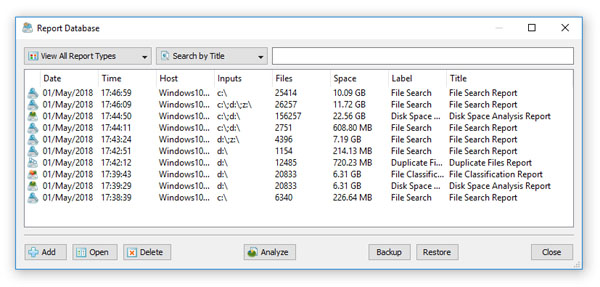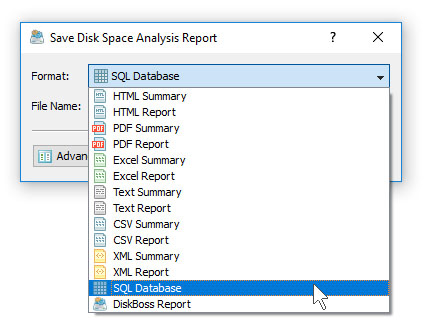DiskBoss Ultimate and DiskBoss Server provide the ability to submit disk space analysis, file classification, duplicate files,
disk change monitoring and file search results into a centralized SQL database through the ODBC interface. In order to connect
DiskBoss to an SQL database, open the options dialog, select the 'Database' tab and specify an ODBC data source, user name and password.

Disk space analysis, file classification, duplicate files detection, disk change monitoring and file search results may be saved
into an SQL database in a very similar way. Just press the 'Save' button on the results dialog and select the 'SQL Database' report format.

IT and storage administrators are provided with the ability to submit disk space analysis, file classification and duplicate files reports
from multiple servers and desktop computers to a centralized SQL database, display charts showing the used disk space, file categories
and duplicate files per user or per host and gain an in-depth visibility into what types of files are consuming the most of the disk
space, who owns these files, where these files are located, how much disk space is wasted on duplicates, etc. across the entire enterprise.

The users analysis dialog provides the ability to display the used disk space, file categories and duplicate files per user. The dialog
allows one to select types of operations, file categories and file system locations to analyze, customize users' display names, edit
the chart's title and footer and finally copy the chart image to the clipboard allowing one to easily integrate DiskBoss charts into
user-custom reports and presentations.

The hosts analysis dialog allows one to display charts showing the disk space usage, file categories and duplicate files per host.
The user is provided with the ability to select types of disk analysis operations, file categories and file system locations to analyze,
customize hosts' display names, edit chart's title and footer and finally copy the chart image to the clipboard.

